Assessing Synergistic Effects on NPP from a Refined Vegetation Perspective: Ecological Projects and Climate in Heilongjiang
Abstract
1. Introduction
- To analyze the differential spatiotemporal evolution patterns of NPP across refined vegetation types in Heilongjiang Province from 2001 to 2020;
- To quantify the dynamic weights of climatic factors—including temperature, precipitation, and vapor pressure deficit (VPD)—on NPP across refined vegetation types;
- To uncover the specific response mechanisms of refined vegetation type’s NPP as driven by the interaction between climatic factors and FYP ecological projects.
2. Study Area, Data, and Methods
2.1. Study Area
2.2. Datasets
2.2.1. NPP Dataset
2.2.2. Climate Datasets
2.2.3. Fine High-Resolution Land Cover Product
2.3. Study Methods
2.3.1. Trend Analysis
2.3.2. Partial Correlation Analysis
2.3.3. PLS-SEM
2.3.4. Multiple Linear Regression
3. Results
3.1. Spatiotemporal Variations of NPP
3.2. Spatiotemporal Dynamics of Climatic Factors
3.3. Relationships Between NPP and Climatic Factors
3.4. The Impact of Climatic Factors and FYP on NPP
3.5. Analysis of Driving Factors Based on PLS-SEM
3.6. Sensitivity Analysis
4. Discussion
4.1. Paradigm Shift in NPP Climatic Drivers
4.2. Drivers of NPP in Heilongjiang
5. Limitation
6. Conclusions
- (1)
- During the 12th FYP, MLF exhibited the highest single-period NPP increase (+58.4 gC·m−2·a−1), significantly exceeding other vegetation types, and emerged as the primary driver of provincial NPP growth. Over the entire study period, DNF showed the highest cumulative NPP gain (+64 gC·m−2·a−1). However, 57%–62% of DNF areas shifted to a declining trend during the 12th–13th FYPs (p < 0.01), reflecting the divergent sensitivity of coniferous vegetation to late-stage climatic and management conditions.
- (2)
- Analysis of climatic driving mechanisms revealed Pre as the key positive driver during the 10th–11th FYPs (positive correlation in 74% of the area), while VPD significantly strengthened and became the primary limiting factor during the 12th–13th FYPs (positive correlation proportion rising to 54%; mean correlation coefficient increasing from 0.031 to 0.078). Tmp predominantly exerted negative effects on NPP throughout the period (negative correlation in 64% of the area; mean correlation coefficient = −0.15), but the extent of negatively affected areas decreased from 65% to 52% during the 12th–13th FYPs, suggesting that FYP ecological projects have partially mitigated warming-induced growth inhibition.
- (3)
- NPP changes in forest vegetation (broad-leaved, coniferous, mixed forests) were primarily governed by VPD (SV values ranging from −0.61 to 0.59), with substantial climatic contributions (400–600 gC·m−2·a−1). In contrast, grasslands and croplands showed high sensitivity to temperature stress (SV values as low as −0.5), weak responses to precipitation and VPD, lower climatic contributions (200–400 gC·m−2·a−1), and limited resilience, demonstrating distinct zonal differentiation. The overall influence of FYP policies was weakly negative (IV_FYP = −2.04) but displayed significant spatial heterogeneity.
Author Contributions
Funding
Data Availability Statement
Acknowledgments
Conflicts of Interest
References
- IPCC. Climate Change 2022: Impacts, Adaptation, and Vulnerability. Contribution of Working Group II to the Sixth Assessment Report of the Intergovernmental Panel on Climate Change; Cambridge University Press: Cambridge, UK; New York, NY, USA, 2022. [Google Scholar]
- Chen, L.; Msigwa, G.; Yang, M.Y.; Osman, A.I.; Fawzy, S.; Rooney, D.W.; Yap, P.S. Strategies to achieve a carbon neutral society: A review. Environ. Chem. Lett. 2022, 20, 2277–2310. [Google Scholar] [CrossRef] [PubMed]
- Wei, X.; Yang, J.; Luo, P.; Lin, L.G.; Lin, K.L.; Guan, J.M. Assessment of the variation and influencing factors of vegetation NPP and carbon sink capacity under different natural conditions. Ecol. Indic. 2022, 138, 108834. [Google Scholar] [CrossRef]
- Yan, F.; Li, C.Y.; Wang, J.; Lu, Z.X.; Huang, X.H.; Wang, M.L.; Wang, W.D.; Li, R.Q.; Pang, J.; Chen, Y.H. Quantitative Analysis of Driving Forces for Spatiotemporal Evolution of Vegetation NPP in the Beijing-Tianjin-Hebei Ecological Barrier Zone. Environ. Sci. 2025, 46, 327–339. [Google Scholar] [CrossRef]
- Li, J.; Liang, W.; Xu, M.; Tian, H.; Gao, X.; Yang, Y.; Hu, R.; Zhang, Y.; Cao, C. Threshold Extraction and Early Warning of Key Ecological Factors for Grassland Degradation Risk. Remote Sens. 2025, 17, 3098. [Google Scholar] [CrossRef]
- Kharuk, V.I.; Petrov, I.A.; Shushpanov, A.S.; Im, S.T.; Ondar, S.O. Scots Pine at Its Southern Range in Siberia: A Combined Drought and Fire Influence on Tree Vigor, Growth, and Regeneration. Forests 2025, 16, 819. [Google Scholar] [CrossRef]
- Kharuk, V.I.; Petrov, I.A.; Im, S.T.; Golyukov, A.S.; Dvinskaya, M.L.; Shushpanov, A.S. Pollution and Climatic Influence on Trees in the Siberian Arctic Wetlands. Water 2023, 15, 215. [Google Scholar] [CrossRef]
- Hui, W.T.; Ru, T.B.; Hong, F.Z.; Yan, J. Driving factors and gradient effect of net primary productivity in Fenhe River Basin. Chin. J. Ecol. 2019, 38, 3066–3074. [Google Scholar] [CrossRef]
- Xi, Z.L.; Chen, G.Z.; Xing, Y.Q.; Xu, H.D.; Tian, Z.Y.; Ma, Y.; Cui, J.; Li, D. Spatial and temporal variation of vegetation NPP and analysis of influencing factors in Heilongjiang Province, China. Ecol. Indic. 2023, 154, 110798. [Google Scholar] [CrossRef]
- Shi, X.L.; Yang, Z.Y.; Wang, X.S.; Gao, J.; Hu, Y. Spatial and temporal variation of net primary productivity and its relationship with climate factors in the Chinese loess plateau. Chin. J. Agrometeorol. 2016, 37, 445–453. [Google Scholar] [CrossRef]
- Wang, C.; Jiang, Q.; Deng, X.; Lv, K.X.; Zhang, Z.H. Spatio-Temporal Evolution, Future Trend and Phenology Regularity of Net Primary Productivity of Forests in Northeast China. Remote Sens. 2020, 12, 3670. [Google Scholar] [CrossRef]
- Cui, J.X.; Wang, Y.D.; Zhou, T.C.; Jiang, L.L.; Qi, Q.W. Temperature Mediates the Dynamic of MODIS NPP in Alpine Grassland on the Tibetan Plateau, 2001–2019. Remote Sens. 2022, 14, 2401. [Google Scholar] [CrossRef]
- Wang, D.D.; Qin, W.; Jia, G.D.; Shan, Z.J.; Hao, M. Assessing the effects of climate variability and vegetation conversion on variations of net primary productivity in the mountainous area of North China. For. Ecol. Manag. 2022, 506, 119957. [Google Scholar] [CrossRef]
- Chen, T.; Huang, Q.; Liu, M.; Qu, L.; Deng, S.L.; Chen, D. Decreasing Net Primary Productivity in Response to Urbanization in Liaoning Province, China. Sustainability 2017, 9, 162. [Google Scholar] [CrossRef]
- Zhang, J.; Zhang, Y.X.; Qin, Y.; Lu, X.; Cao, J.J. The spatiotemporal pattern of grassland NPP in Inner Mongolia was more sensitive to moisture and human activities than that in the Qinghai-Tibetan Plateau. Glob. Ecol. Conserv. 2023, 48, e02709. [Google Scholar] [CrossRef]
- Wang, Z.; Bai, T.; Xu, D.; Kang, J.; Shi, J.; Fang, H.; Nie, C.; Zhang, Z.J.; Yan, P.W.; Wang, D.N. Temporal and Spatial Changes in Vegetation Ecological Quality and Driving Mechanism in Kökyar Project Area from 2000 to 2021. Sustainability 2022, 14, 7668. [Google Scholar] [CrossRef]
- Fu, A.; Li, W.; Chen, Y.N.; Wang, Y.; Hao, H.C.; Li, Y.P.; Sun, F.; Zhou, H.H.; Zhu, C.G.; Hao, X.M. The effects of ecological rehabilitation projects on the resilience of an extremely drought-prone desert riparian forest ecosystem in the Tarim River Basin, Xinjiang, China. Sci. Rep. 2021, 11, 18485. [Google Scholar] [CrossRef] [PubMed]
- Cheng, C.; Yu, M.; Mao, Z.; Xie, L.; Zhang, Y.; Sun, T.; Xu, Z.; Wu, S.; Li, Q.; Xu, J. Spatio-temporal Evolution and Mutation Patterns of NPP in Heilongjiang Province Under the Process of Ecological Protection and Restoration in China. J. For. Sci. 2022, 58, 23–31. [Google Scholar] [CrossRef]
- Zhang, J.; Zhang, Y. Quantitative Assessment of the Impact of the Three-North Shelter Forest Program on Vegetation Net Primary Productivity over the Past Two Decades and Its Environmental Benefits in China. Sustainability 2024, 16, 3656. [Google Scholar] [CrossRef]
- Hu, A.; Yan, Y.; Lyu, J. An Important Means of China’s Development Miracle: Taking the Transformation of Five-Year Plans as an Example (from the 6th Five-Year Plan to the 11th Five-Year Plan). J. Tsinghua Univ. 2011, 26, 43–52+158. [Google Scholar] [CrossRef]
- Gao, J.; Liu, Y. Climate warming and land use change in Heilongjiang Province, Northeast China. Appl. Geogr. 2011, 31, 476–482. [Google Scholar] [CrossRef]
- Liu, S.; Ding, Z.; Lin, Y.; Yao, S.B. The Efficiency of Forest Management Investment in Key State-Owned Forest areas under the Carbon Neutral Target: A Case Study of Heilongjiang Province, China. Forests 2022, 13, 609. [Google Scholar] [CrossRef]
- Gao, C.Y. Simulation of Forest Carbon Cycle in Heilongjiang Province under Climate Change Scenarios. Ph.D. Thesis, Northeast Forestry University, Harbin, China, 2016. [Google Scholar]
- Gao, J.; Liu, Y. Deforestation in Heilongjiang Province of China, 1896–2000: Severity, spatiotemporal patterns and causes. Appl. Geogr. 2012, 35, 345–352. [Google Scholar] [CrossRef]
- Wu, Z.; Li, M.; Wang, B.; Tian, Y.P.; Quan, Y.; Liu, J.Y. Analysis of Factors Related to Forest Fires in Different Forest Ecosystems in China. Forests 2022, 13, 1021. [Google Scholar] [CrossRef]
- Ma, F.; Jiang, Q.; Xu, L.; Lv, K.X.; Chang, G.L. Processes, potential, and duration of vegetation restoration under different modes in the eastern margin ecotone of Qinghai-Tibet Plateau. Ecol. Ind. 2021, 132, 108267. [Google Scholar] [CrossRef]
- Wang, Y.; Tang, W.; Li, S.; Zhao, H.Y.; Xie, J.L.; Ma, C.; Yan, C.Z. Change in grassland productivity in Qinghai Province and its driving factors. Acta Prataculturae Sin. 2022, 31, 1–13. [Google Scholar] [CrossRef]
- Peng, S. 1-km Monthly Precipitation Dataset for China (1901–2024); National Tibetan Plateau/Third Pole Environment Data Center: Beijing, China, 2020; Available online: https://data.tpdc.ac.cn/en/data/faae7605-a0f2-4d18-b28f-5cee413766a2 (accessed on 8 October 2025).
- Peng, S. 1-km Monthly Mean Temperature Dataset for China (1901–2022); National Tibetan Plateau/Third Pole Environment Data Center: Beijing, China, 2019. [Google Scholar] [CrossRef]
- Li, Q.; Liu, X.; Zhang, H.; Thomas, C.P.; David, R.E. Detecting and adjusting temporal inhomogeneity in Chinese mean surface air temperature data. Adv. Atmos. Sci. 2004, 21, 260–268. [Google Scholar] [CrossRef]
- Hutchinson, M.F. Interpolating mean rainfall using thin plate smoothing splines. Int. J. Geogr. Inf. Syst. 1995, 9, 385–403. [Google Scholar] [CrossRef]
- He, J.; Yang, K.; Tang, W.; Lu, H.; Qin, J.; Chen, Y.Y.; Li, X. The first high-resolution meteorological forcing dataset for land process studies over China. Sci. Data 2020, 7, 25. [Google Scholar] [CrossRef]
- Jin, J.; Xiao, Y.; Jin, J.; Zhu, Q.A.; Yong, B.; Ji, Y.Y. Temporal and spatial variation characteristics of extreme hydro meteorological events in the Yangtze River Basin and their impact on vegetation. Prog. Water Sci. 2021, 32, 867–876. [Google Scholar] [CrossRef]
- Zhang, H.; Luo, M.; Zhan, W.; Zhao, Y.Q.; Yang, Y.J.; Ge, E.J.; Ning, G.C. HiMIC-Monthly: A 1 km High-Resolution Atmospheric Moisture Index Collection over China, 2003–2020, 2003–2020; National Tibetan Plateau/Third Pole Environment Data Center: Beijing, China, 2023. [Google Scholar] [CrossRef]
- Liu, L.B.; Gudmundson, L.; Hauser, M.; Qin, D.H.; Li, S.C.; Sonia, I.S. Soi moisture dominates dyness stress on ecosystem production gilobaly. Nat. Commun. 2020, 1, 4892. [Google Scholar] [CrossRef] [PubMed]
- Zhang, X.; Liu, L.; Chen, X.; Gao, Y.; Xie, S.; Mi, J. GLC_FCS30: Global land-cover product with fine classification system at 30 m using time-series Landsat imagery. Earth Syst. Sci. Data 2021, 13, 2753–2776. [Google Scholar] [CrossRef]
- Deng, X.Y.; Liu, Y.; Liu, Z.H.; Wu, H.; Zhang, C.; Xie, H.J.; Li, J. Temporal-spatial dynamic change characteristics of evapotranspiration in arid region of Northwest China. Acta Ecol. Sin. 2017, 37, 2994–3008. [Google Scholar] [CrossRef]
- Song, Y.; Gao, M.; Wang, Z.; Wang, Z.R.; Wang, J.F.; Xu, Z.X. Exploration of spatiotemporal variation characteristics and driving factors of cultivated land NPP in the Shandong region of the Bohai Sea. Environ. Sci. 2024, 45, 4733–4743. [Google Scholar] [CrossRef]
- Wang, G.J.; Peng, W.F.; Zhang, L.D.; Zhang, J. Quantifying the impacts of natural and human factors on changes in NPP using an optimal parameters-based geographical detector. Ecol. Indic. 2023, 155, 111018. [Google Scholar] [CrossRef]
- Liu, X.; Luo, Z.; Xiao, H. Temporal and spatial variations of vegetation monthly NPP in the green heart area of Changsha Zhuzhou Xiangtan and its response to climatic and topographic factors. Environ. Sci. 2024, 45, 6888–6898. [Google Scholar] [CrossRef]
- Zhao, J.; Du, Z.Q.; Wu, Z.H.; Zhang, H.; Guo, N.; Ma, Z.T.; Liu, X.J. Seasonal variations of day and nighttime warming and their effects onvegetation dynamics in China’s temperate zone. Acta Geogr. Sin. 2018, 73, 395–404. [Google Scholar] [CrossRef]
- Jin, K.; Wang, F.; Han, C.; Shi, S.Y.; Ding, W.B. The impact of climate change and human activities on vegetation NDVI changes in China from 1982 to 2015. Acta Geogr. Sin. 2020, 75, 961–974. [Google Scholar] [CrossRef]
- Yang, H.; Xing, Y.; Chang, X.; Wang, J.Q.; Li, Y.X.; Tang, J.; Wang, D.J. Internal response of vegetation growth to degrees of permafrost degradation in Northeast China from 2001 to 2020. Geo-Spat. Inf. Sci. 2025, 28, 265–283. [Google Scholar] [CrossRef]
- Wang, Y.B.; Zhao, Y.H.; Han, L.; Ao, Y. Spatiotemporal variation of vegetation net primary productivity and its driving factors from 2000 to 2015 in Qinling-Daba Mountains, China. J. Appl. Ecol. 2018, 29, 2373–2381. [Google Scholar] [CrossRef]
- Wei, Y.; Yu, D.; Lewis, B.J.; Zhou, L.; Zhou, W.M.; Fang, X.M.; Zhao, W.; Wu, S.N.; Dai, L.M. Forest carbon storage and tree carbon pool dynamics under natural forest protection program in northeastern China. Chin. Geogr. Sci. 2014, 24, 397–405. [Google Scholar] [CrossRef]
- Wen, Z.; Zhou, Z.; Wei, X.; Xiao, D.; Xu, L.; Wan, W. Spatio-Temporal Simulation of the Productivity of Four Typical Subtropical Forests: A Case Study of the Ganjiang River Basin in China. Forests 2025, 16, 603. [Google Scholar] [CrossRef]
- Dan, Z.; Liu, D.; Luo, H.; Liu, J.W.; Zhang, L.M.; Wei, Y.H. The impact of human activities on the net primary productivity of vegetation in the Chengde Jieba area under the background of climate change. Environ. Sci. 2023, 44, 6215–6225. [Google Scholar] [CrossRef]
- Cheng, C.; Yu, M.; Wu, M.; Bo, Y.; Mao, Z.J. Analysis of driving factors of land vegetation NPP in Heilongjiang Province from 2000 to 2020. J. Northeast. Agric. Univ. 2022, 53, 20–28+75. [Google Scholar] [CrossRef]
- Wang, B.; Li, M.; Fan, W.; Yu, Y.; Chen, J.M. Relationship between Net Primary Productivity and Forest Stand Age under Different Site Conditions and Its Implications for Regional Carbon Cycle Study. Forests 2018, 9, 5. [Google Scholar] [CrossRef]
- Wang, Y.; Tong, X.; Li, J.; Yang, M.X.; Wang, Y. Impacts of Climate Change and Human Activities on Vegetation Productivity in China. Remote Sens. 2025, 17, 1724. [Google Scholar] [CrossRef]
- Chen, J.; Dai, A.; Zhang, Y. Linkage between Projected Precipitation and Atmospheric Thermodynamic Changes. J. Clim. 2020, 33, 7155–7178. [Google Scholar] [CrossRef]
- Du, G.; Yan, S.; Chen, H.; Yang, J.; Wen, Y. Intra-Annual Cumulative Effects and Mechanisms of Climatic Factors on Global Vegetation Biomes’ Growth. Remote Sens. 2024, 16, 779. [Google Scholar] [CrossRef]
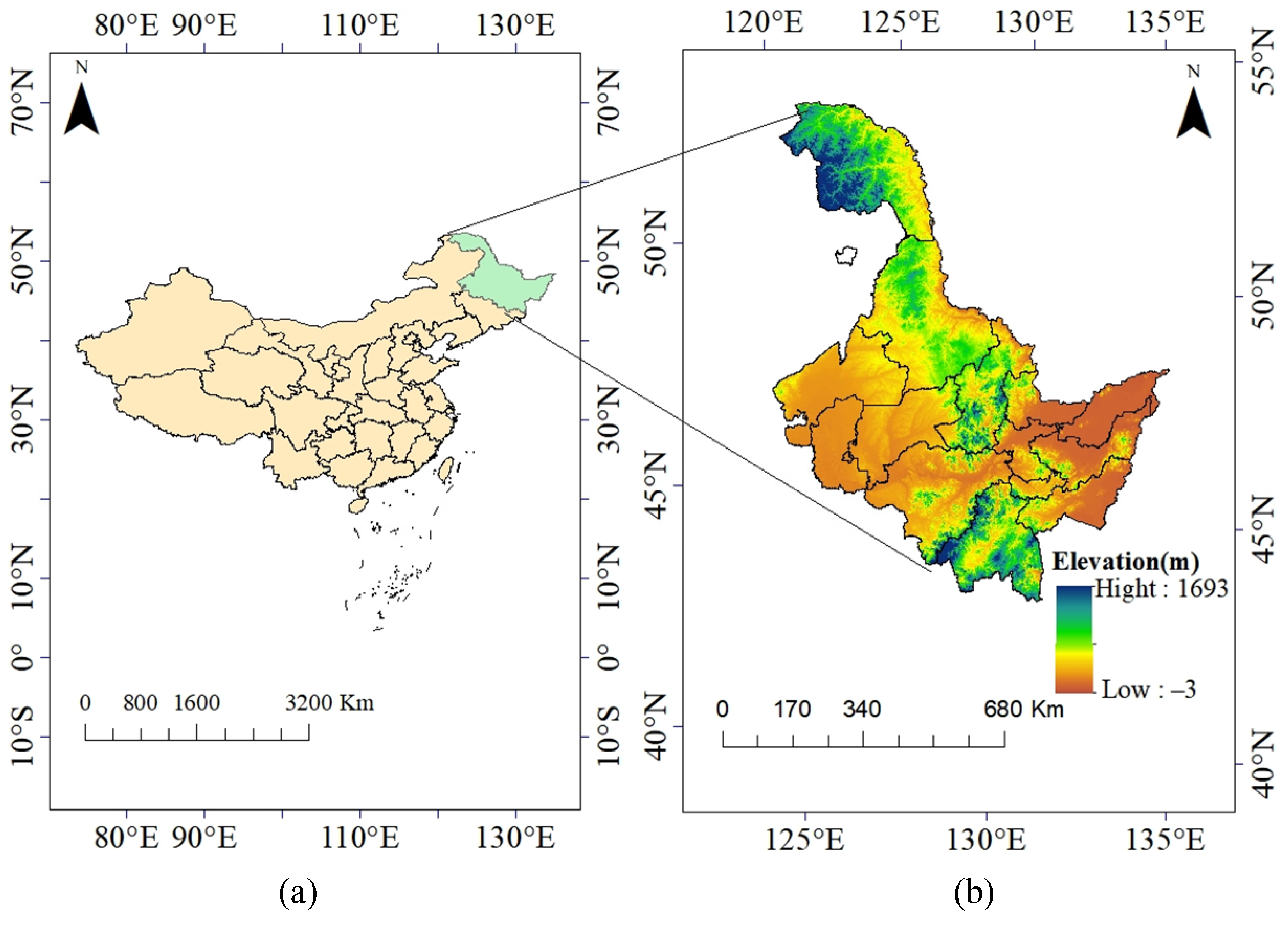
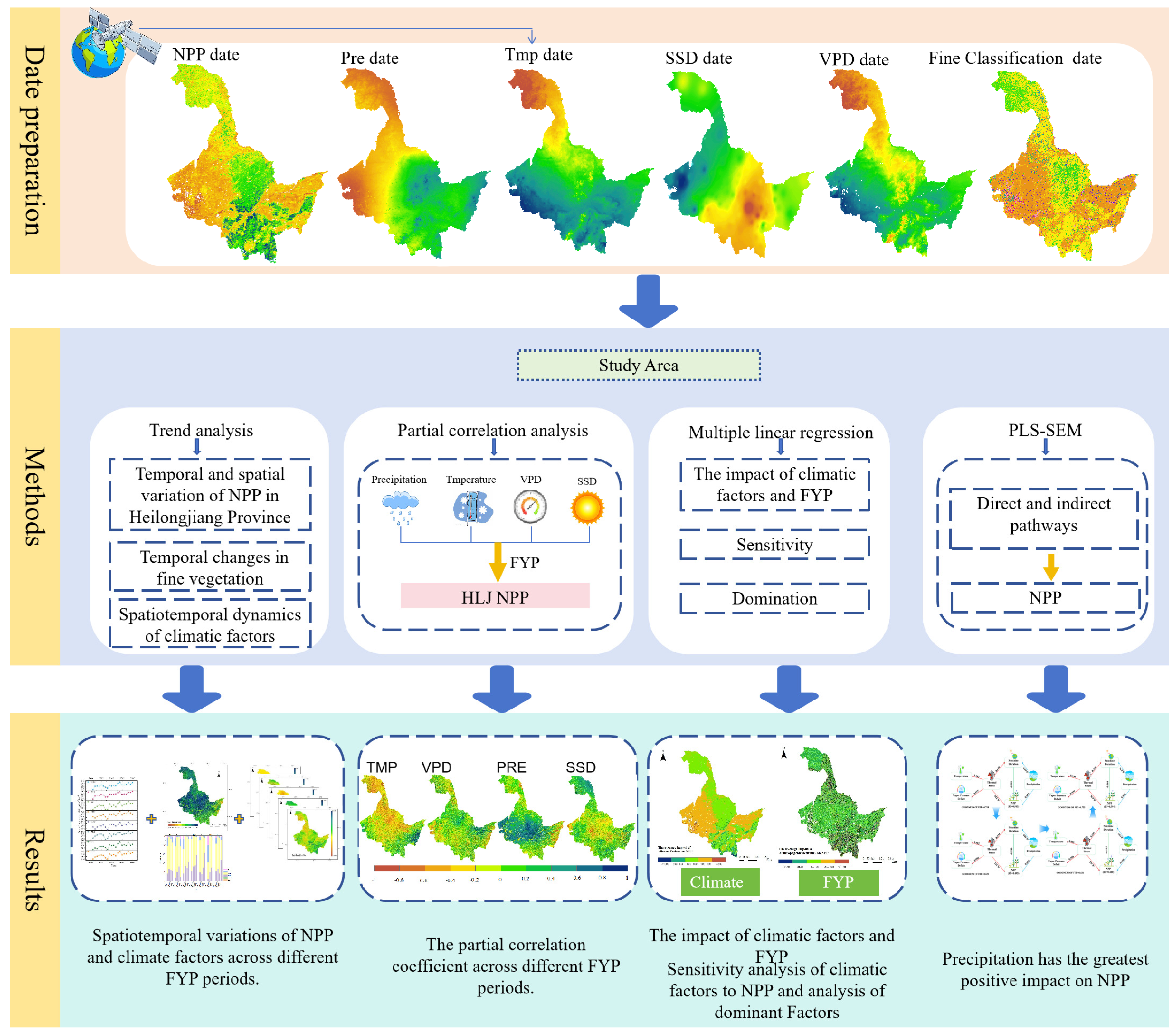
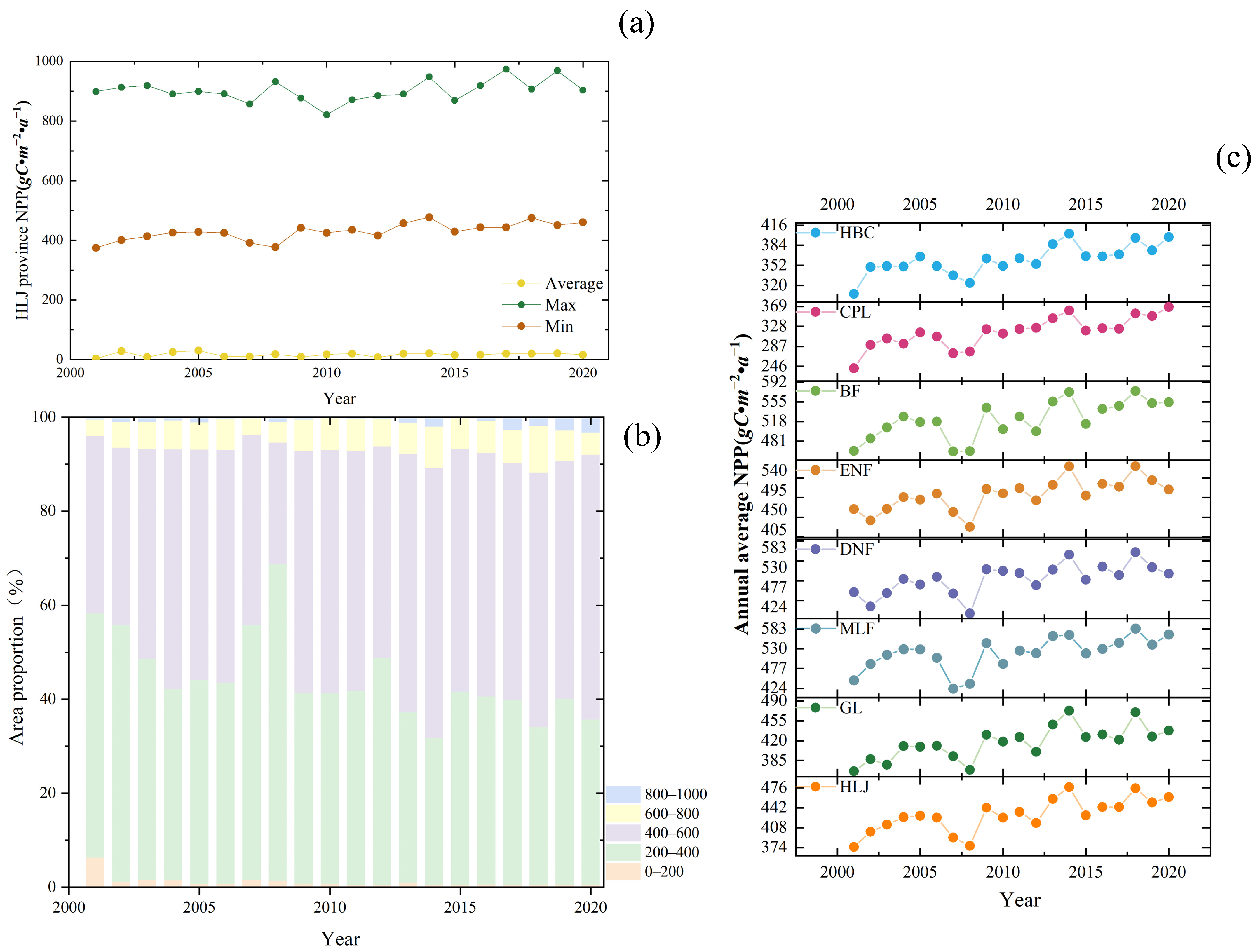
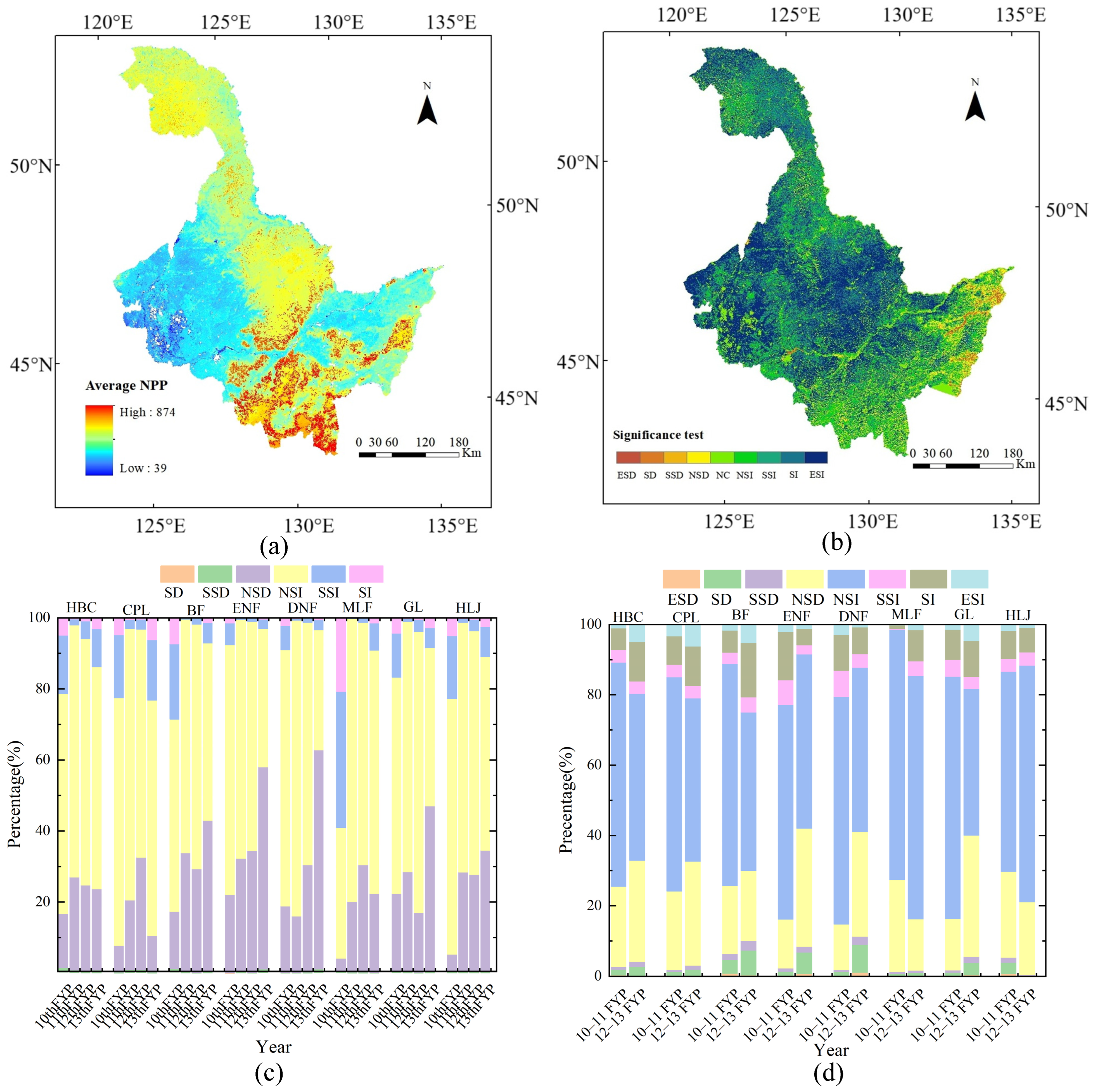
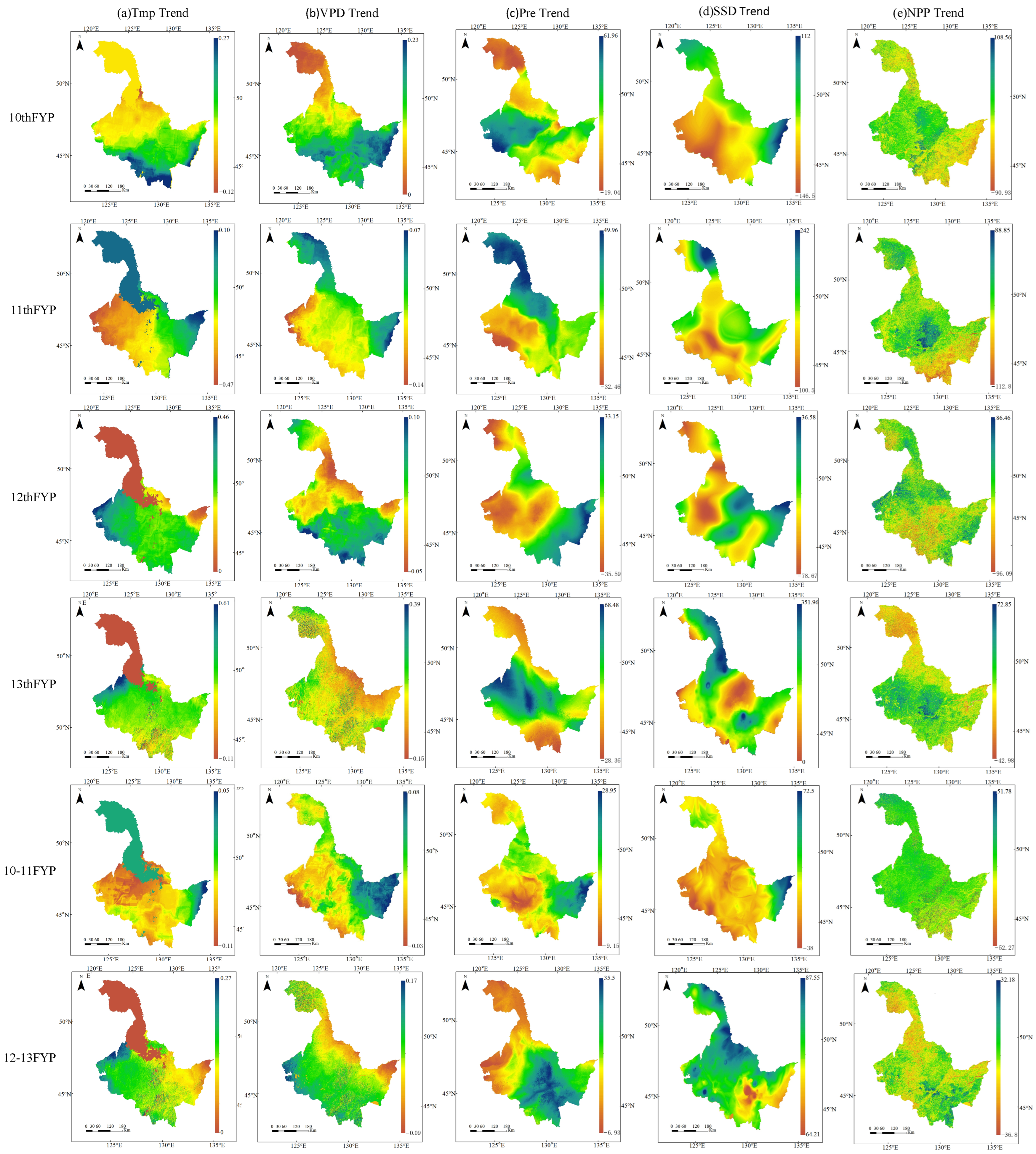
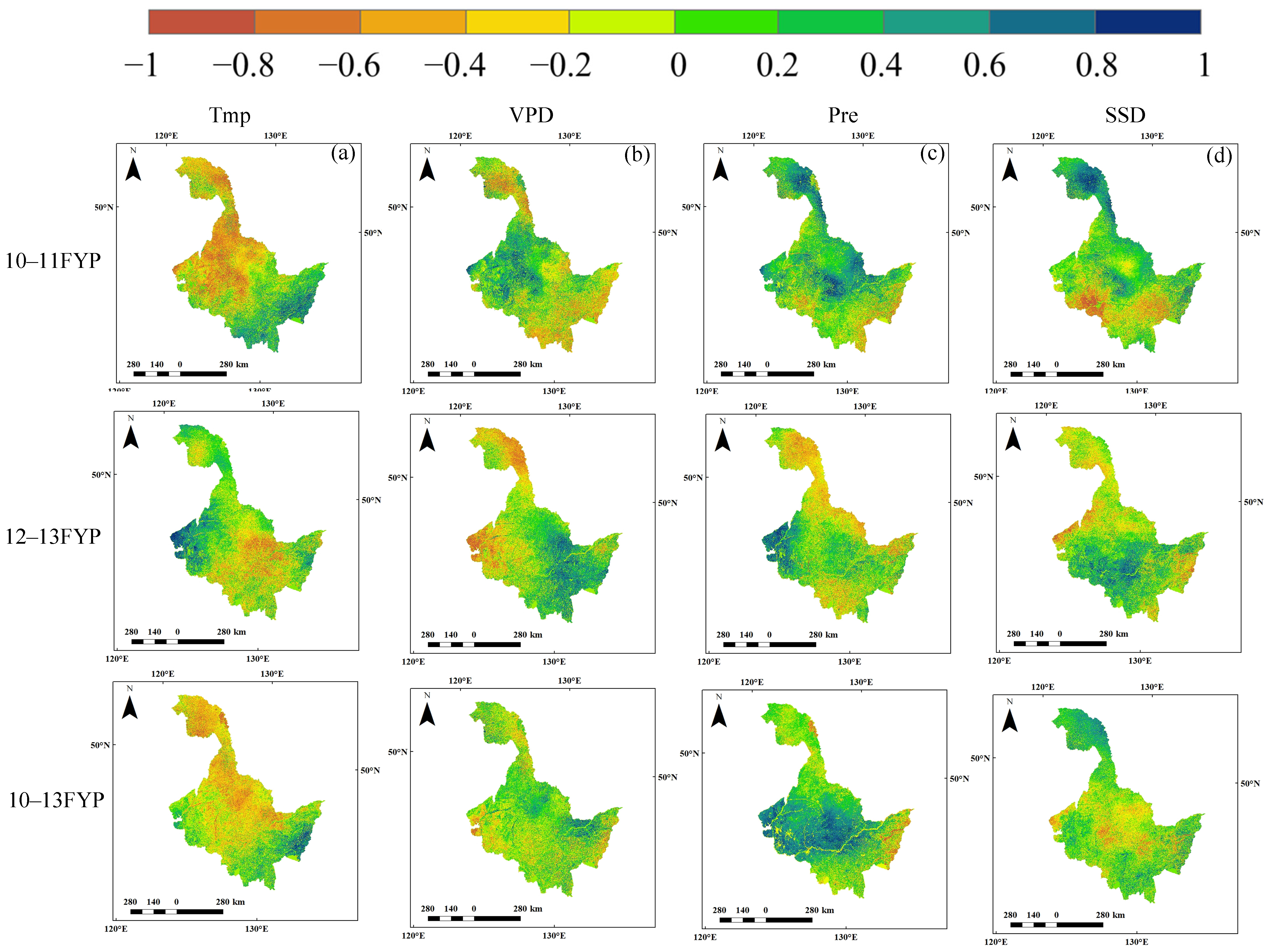
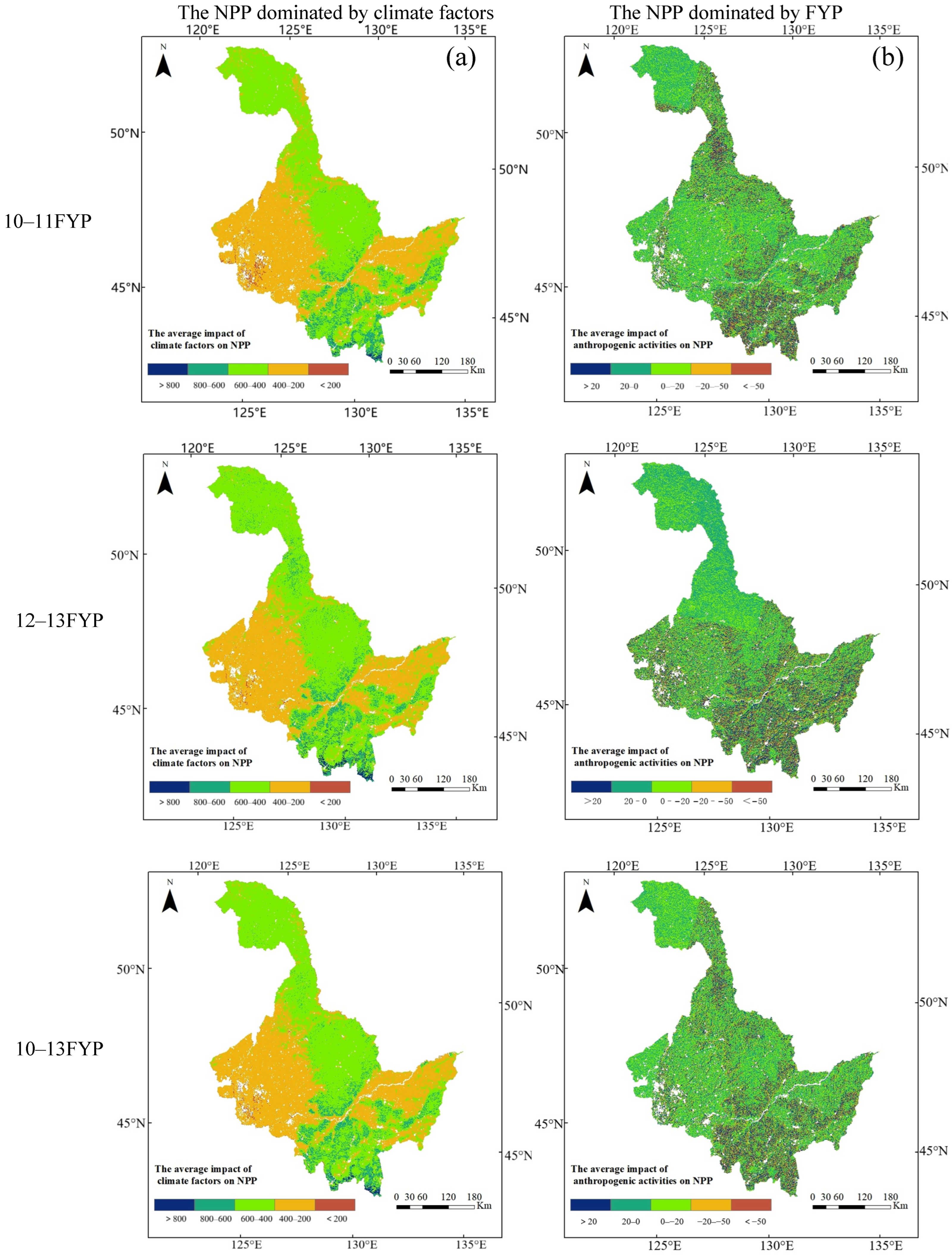
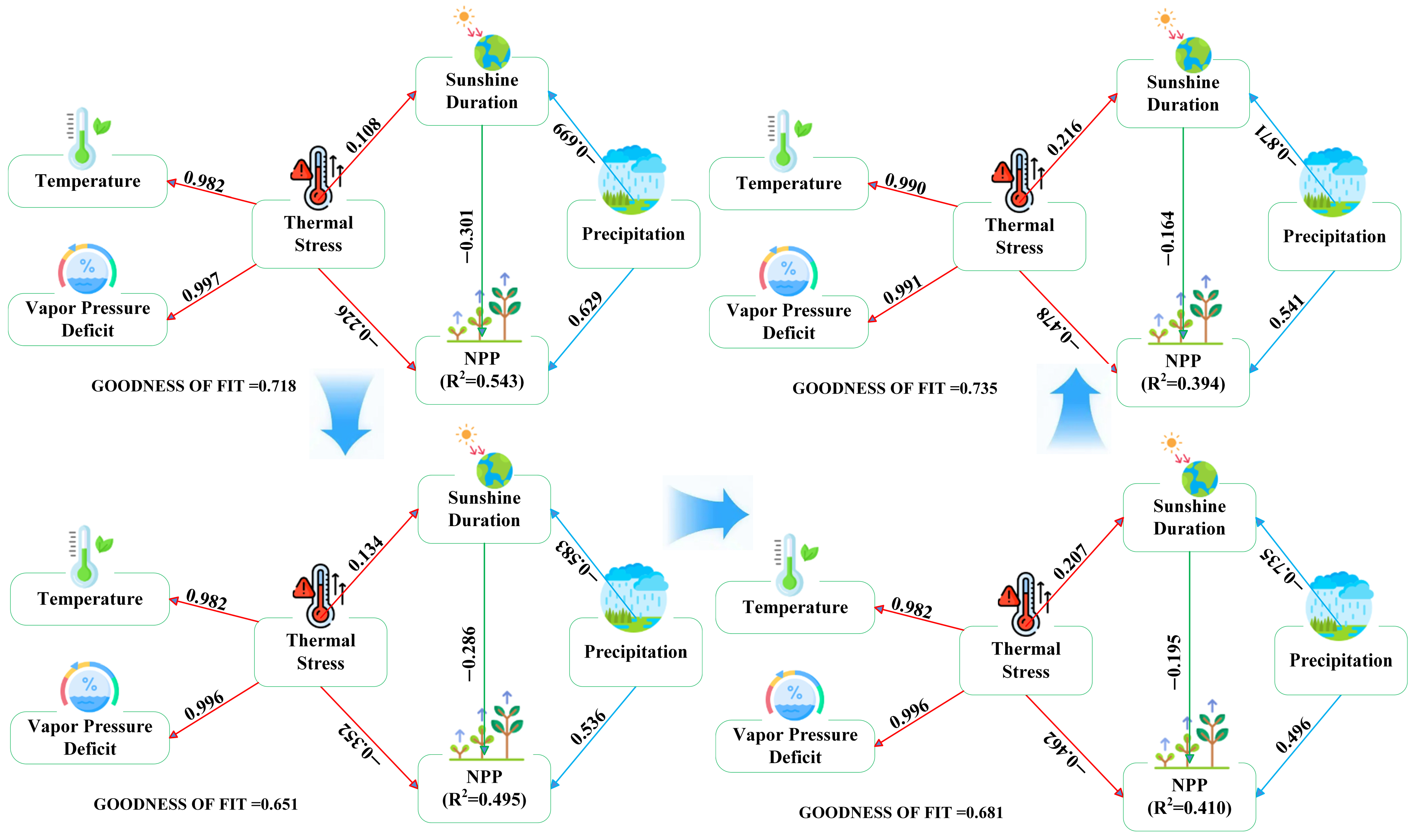
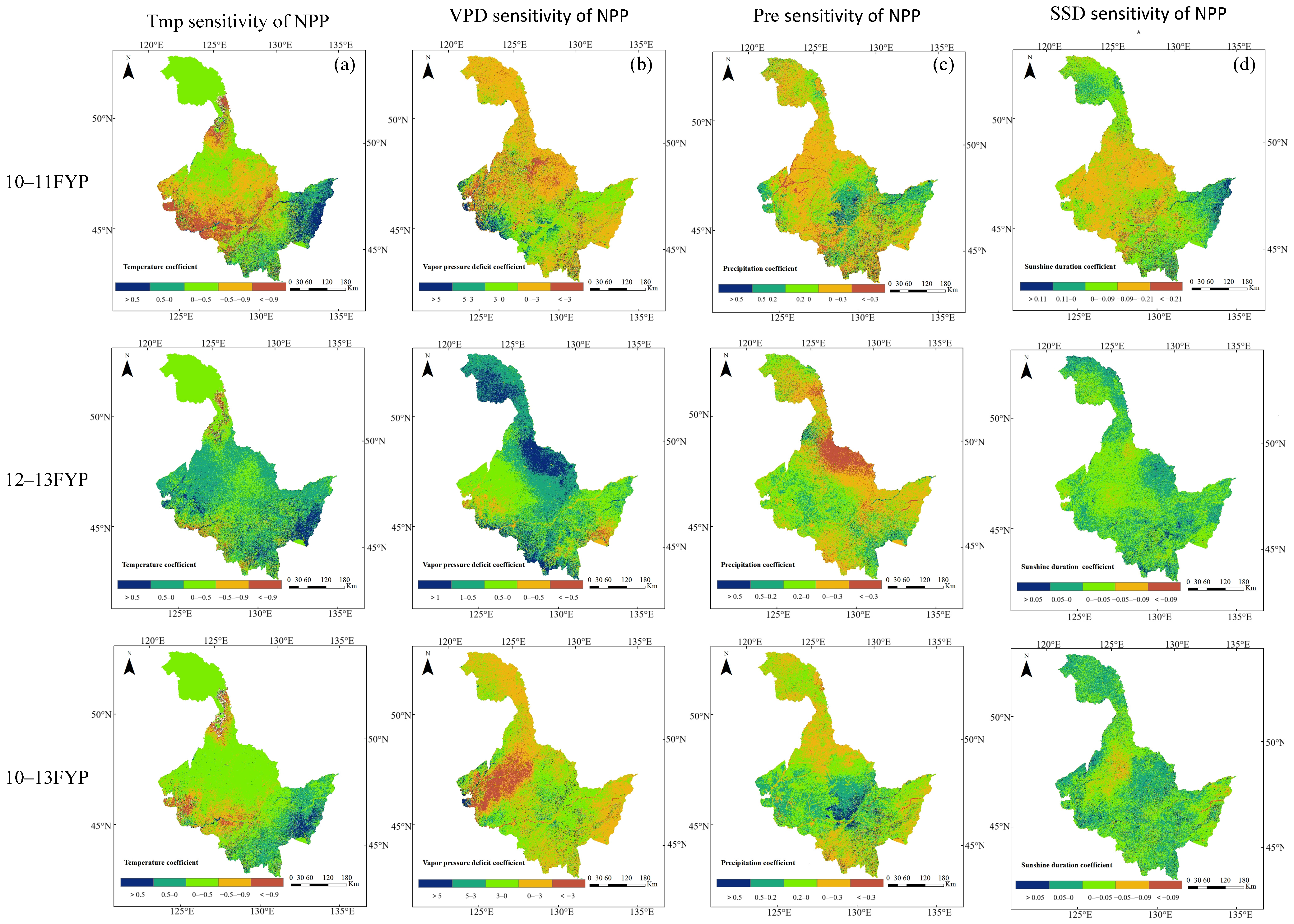
| Data | Year | Resolution | Unit | Data Resource |
|---|---|---|---|---|
| NPP | 2000–2020 | 500 m | gC/m2 | Google Earth Engine (https://developers.google.com/earth-engine accessed on 25 July 2025) |
| Fine high-resolution land cover product | 2005, 2010, 2015, and 2020 | 30 m | - | Earth Big Data Science Engineering Data Network (https://data.casearth.cn) |
| Temperature | 2000–2020 | 1000 m | °C | National Tibetan Plateau Data Center (https://data.tpdc.ac.cn) |
| Precipitation | 2000–2020 | 1000 m | mm | National Tibetan Plateau Data Center (https://data.tpdc.ac.cn) |
| Sunshine duration | 2000–2020 | 1000 m | h | National Basic Meteorological Elements Daily Dataset of China’s Surface Meteorological Stations (V3.0) (http://data.cma.cn/en) |
| Vegetation Types | 10th FYP Slope | 11th FYP Slope | 12th FYP Slope | 13th FYP Slope | 10–13 FYP Slopes |
|---|---|---|---|---|---|
| HBC | 0.011 | 0.002 | 0.005 | 0.006 | 0.0030 ** |
| CPL | 0.015 | 0.006 | 0.002 | 0.011 | 0.0043 |
| BF | 0.015 | 0.005 | 0.004 | 0.003 | 0.0041 ** |
| ENF | 0.009 | 0.005 | 0.004 | −0.001 | 0.0042 |
| DNF | 0.011 | 0.009 | 0.004 | −0.001 | 0.0046 |
| MLF | 0.02 | 0.008 | 0.003 | 0.007 | 0.0046 |
| GL | 0.011 | 0.005 | 0.007 | 0.002 | 0.0035 |
| Vegetation Types | 10th FYP (gC·m−2·a−1) | 11th FYP (gC·m−2·a−1) | 12th FYP (gC·m−2·a−1) | 13th FYP (gC·m−2·a−1) |
|---|---|---|---|---|
| HBC | 344.62 | 345.03 | 374.46 | 380.80 |
| CPL | 288.68 | 298.28 | 334.52 | 343.73 |
| BF | 499.79 | 497.77 | 533.84 | 554.06 |
| ENF | 473.27 | 482.51 | 518.81 | 532.03 |
| DNF | 449.28 | 465.88 | 499.16 | 513.60 |
| MLF | 501.23 | 480.06 | 538.50 | 553.87 |
| GL | 390.24 | 404.32 | 434.94 | 437.56 |
Disclaimer/Publisher’s Note: The statements, opinions and data contained in all publications are solely those of the individual author(s) and contributor(s) and not of MDPI and/or the editor(s). MDPI and/or the editor(s) disclaim responsibility for any injury to people or property resulting from any ideas, methods, instructions or products referred to in the content. |
© 2025 by the authors. Licensee MDPI, Basel, Switzerland. This article is an open access article distributed under the terms and conditions of the Creative Commons Attribution (CC BY) license (https://creativecommons.org/licenses/by/4.0/).
Share and Cite
Xia, T.; Huang, J. Assessing Synergistic Effects on NPP from a Refined Vegetation Perspective: Ecological Projects and Climate in Heilongjiang. Forests 2025, 16, 1574. https://doi.org/10.3390/f16101574
Xia T, Huang J. Assessing Synergistic Effects on NPP from a Refined Vegetation Perspective: Ecological Projects and Climate in Heilongjiang. Forests. 2025; 16(10):1574. https://doi.org/10.3390/f16101574
Chicago/Turabian StyleXia, Tingting, and Jiapeng Huang. 2025. "Assessing Synergistic Effects on NPP from a Refined Vegetation Perspective: Ecological Projects and Climate in Heilongjiang" Forests 16, no. 10: 1574. https://doi.org/10.3390/f16101574
APA StyleXia, T., & Huang, J. (2025). Assessing Synergistic Effects on NPP from a Refined Vegetation Perspective: Ecological Projects and Climate in Heilongjiang. Forests, 16(10), 1574. https://doi.org/10.3390/f16101574







